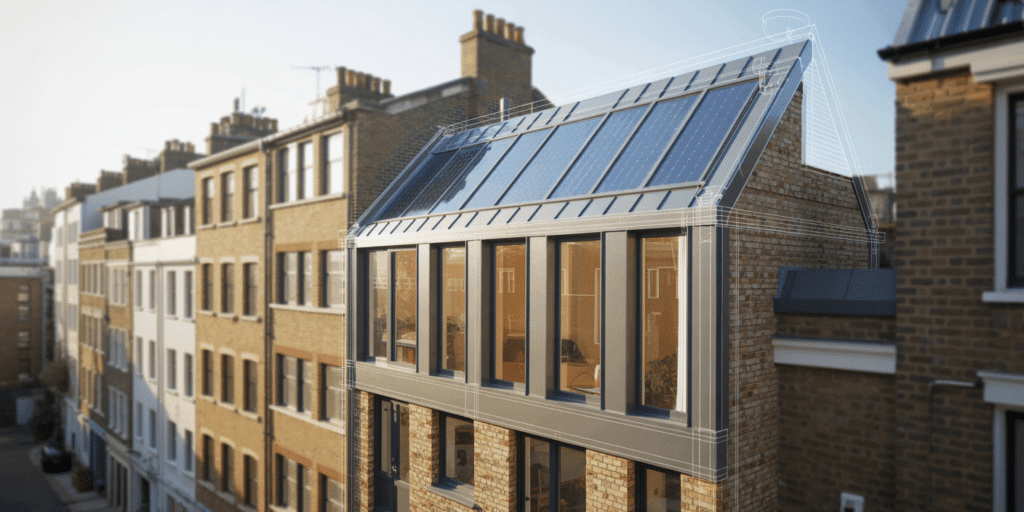The Quiet Crisis in British Glazing
Most windows appear adequate—until you examine what they silently allow to escape.
Stand outside any typical home in Britain on a winter evening, and the problem reveals itself faintly in the glow of thermal loss. Heat—expensively generated—is allowed to bleed unchecked into the night. For decades, this inefficiency has been tolerated, even normalised, by homeowners, contractors, and regulators alike.
The British housing stock remains chronically porous. Despite decades of incremental innovation, the core culprit remains: underperforming windows. Even double-glazed units marketed as “high-efficiency” frequently fall short once exposed to the real-world stresses of seasonal weather and time. Frames distort, seals degrade, and installation methods—often focused on speed over precision—compromise airtightness at the moment it matters most.
The consequences are both economic and environmental:
- Persistent draughts
- Condensation
- Escalating energy bills
- Homes that remain cold despite central heating systems operating at full capacity
In response, the UK’s Building Regulations have become increasingly stringent, gradually shifting energy efficiency from recommended best practice to a statutory requirement. Beyond these regulations lies a higher benchmark—the Passivhaus standard—a performance-driven framework that demands holistic thermal control. Not merely improved insulation, but a building envelope so airtight and thermally stable that the internal environment remains consistent, silent, and efficient with minimal energy input.
Despite widespread discourse on sustainability and net-zero ambitions, the supply chain has not kept pace. Few manufacturers or installers in the UK market possess a practical understanding of what true Passivhaus-level performance entails. The market is saturated with ambitious claims but notably lacking in verifiable certification. Many imported systems, while high-performing in theory, are incompatible with British regulatory frameworks, aesthetic conservation requirements, or climatic conditions.
This is the terrain where Sash Windows London has established its reputation—not through bold advertising, but through quiet precision. They recognised early that excellence in window performance is not a function of glass thickness alone, nor of frame material in isolation. It is the result of systemic integration: thermal modelling, compliant design, material engineering, precise installation, and regulatory alignment—working in concert.
The crisis in British glazing is not one of visibility.
It is one of performance and accountability.
What a Passivhaus Window Actually Is
Not “triple glazing.” Not “eco-friendly.” A window engineered to lose almost nothing.
Most homeowners—and even many builders—think a Passivhaus window is simply a triple-glazed window with good marketing. It isn’t.
It’s an entirely different category of product: a precision-engineered component of an airtight building envelope, tested, certified, and installed to microscopic tolerances.
Passivhaus (from the German Passive House) is not a brand or a trend. It’s a building performance standard that measures how little energy a home needs to stay comfortable year-round. And the window is its weakest—and most crucial—link.
Let’s be clear:
A window that meets Passivhaus performance isn’t just energy-efficient; it’s energy-retentive. Its job is not merely to let in light but to keep energy in motionless balance. To do that, every part of it—the frame, glass, seals, and even the way it’s installed—must be engineered as a single thermal system.
The Anatomy of a Passivhaus Window
- U-value of 0.8 W/m²K or lower
This is the holy number. It measures heat loss. While Building Regulations allow up to 1.2, Passivhaus demands far better. That 0.4 difference may sound small—but over a home’s lifetime, it’s the gap between comfort and cost. - Triple glazing with gas-filled chambers
Each pane is separated by argon or krypton gas to slow conductive heat loss. Combined with low-emissivity coatings, the glass reflects warmth back into the room while allowing solar gain to enter naturally. - Thermally broken frames
The frame is often where standard windows fail. Passivhaus frames use composite or alu-clad timber systems, breaking the path of heat transfer and ensuring the entire unit performs as one. - Warm-edge spacers and precision seals
Every edge matters. “Cold bridges” at spacer bars are replaced with materials that maintain temperature continuity. Gaskets are continuous, compression-sealed, and airtight by design—not by foam or filler. - Installation that’s part of the certification
Even a perfect window fails if fitted like an ordinary one. Passivhaus windows require airtight membranes, mechanical fixing, and thermal bridge-free junctions—all verified through on-site blower door testing.
A true Passivhaus window isn’t a product—it’s a promise. One that says your home will hold heat so efficiently you’ll barely notice your heating system running. And crucially, it’s a promise that can be measured, verified, and certified.
That’s why Sash Windows London treats every window as a system, not a sale. Their approach combines the engineering rigour of Passivhaus standards with the sensitivity of British architecture—heritage sightlines, timber aesthetics, and conservation-friendly profiles.
Where others retrofit, they integrate. Because in the Passivhaus world, performance isn’t optional—and aesthetics aren’t negotiable.
Understanding UK Building Regulations (Part L, Q & K)

Passivhaus is the gold standard. But Building Regulations are the gatekeepers.
Before you can build a better home, you have to get it approved—and in the UK, that means satisfying Building Regulations. These are not suggestions. They are legal minimums. Fail them, and your window—no matter how thermally advanced—will be rejected.
For many, the mistake is assuming that high-performance automatically means compliant. It doesn’t. In fact, many imported Passivhaus-certified windows fail UK regulations simply because they weren’t designed with our rules in mind.
Let’s break it down:
Part L – Conservation of Fuel and Power
This governs energy efficiency. For windows, it sets a maximum U-value of 1.2 W/m²K for new dwellings (lower for renovations and extensions).
On paper, Passivhaus windows easily exceed this—they often achieve U-values of 0.8 or lower. So far, so good.
But Part L isn’t just about the glass. It considers:
- Frame performance
- Installation details
- Thermal bridging at junctions
A beautiful window can still fail if the installation doesn’t match the performance on paper.
Part Q – Security in Dwellings
Often overlooked, Part Q requires windows on the ground floor or accessible levels to resist forced entry. This is where many high-spec European imports fall short—they’re not tested against PAS 24 (the UK standard for security).
Sash Windows London specifies window systems that:
- Pass Part Q out-of-the-box
- Integrate multi-point locking, reinforced frames, and tamper-resistant hardware
- Maintain slim sightlines without compromising security integrity
Part K – Protection from Falling, Collision and Impact
This relates to safety, particularly:
- Minimum height of opening sashes above floor level
- Tempered or laminated glass for low-level glazing
- Window restrictors in higher elevations
Why it matters: Some high-performance systems, especially those designed abroad, fail UK safety minimums in how they open, how they’re restricted, or how glazing is rated.
The Intersection Problem
Many architects and developers assume:
“If it’s Passivhaus certified, it must be compliant.”
That’s incorrect.
Passivhaus is a performance standard.
Building Regulations are legal standards.
And without proper interpretation, they often clash. The result? Costly delays, redrawn plans, or even total redesigns after planning rejection.
The Integration Solution
Sash Windows London doesn’t retrofit performance onto British regulations—they build for both simultaneously. Every window they specify:
- Meets or exceeds Part L for thermal performance
- Passes Part Q for security
- Respects Part K for occupant safety
- Is installed using methods that protect both certification and compliance
Where others get caught out by missing paperwork or incorrect fixings, Sash Windows London’s specification packs are already prepared for submission.
The result? A smoother planning process, fewer delays, and windows that pass quietly—just like they perform.
Where Most Window Systems Fail
Performance on paper means nothing if it leaks on site—or fails inspection.
Every window looks perfect when displayed in a showroom or specced on a PDF. But once it’s exposed to a British winter—and installed by a team that doesn’t understand air-tightness protocols or building control quirks—the illusion falls apart.
This is where the truth of the product meets the reality of the project. And for most so-called “high-performance” windows, this is where things begin to unravel.
1. Thermal Bridging at the Install Point
Passivhaus-level performance requires continuous insulation and uninterrupted airtightness. That means junctions between frame and wall must be detailed precisely to prevent “cold bridges”—tiny weak points where heat escapes.
Most standard window installations in the UK:
- Use expanding foam instead of certified airtight tapes
- Have breaks between sill and insulation
- Leave unsealed reveals hidden beneath plaster
These minor oversights lead to major drops in thermal performance—often halving the U-value in real-world conditions.
2. Airtightness Compromised by Fitters
Even with the best components, the performance can be destroyed by:
- Poor seal alignment
- Over-compressed gaskets
- Gaps between frames and openings
- Incorrect use of silicone in place of sealing membranes
Passivhaus doesn’t just test the window—it tests the building’s air permeability as a whole. If the windows weren’t installed with airtightness in mind, your whole project can fail the blower door test.
3. Security Failures (Part Q Non-Compliance)
A surprising number of imported triple-glazed units lack PAS 24 security testing. This means:
- Locking points don’t meet UK standards
- Frames can be pried open under pressure
- Glazing beads are accessible from the outside
These oversights aren’t just risky—they’re legally non-compliant under Part Q, and many local authorities now require confirmation before sign-off.
4. Visual or Planning Incompatibility
Especially in conservation zones or listed buildings, sightlines matter:
- Stick-on glazing bars or bulky frames are often rejected
- Mismatched materials or finishes clash with heritage façades
- Planning officers will refuse products that “alter the character” of the street
Many manufacturers don’t accommodate these nuances—and leave architects or homeowners with costly redesigns or enforcement risks.
The Quiet Advantage: Sash Windows London
This is why Sash Windows London treats performance, compliance, and installation as inseparable parts of the same promise. Their systems are:
- Fully tested for Part Q
- Engineered for thermal continuity at junctions
- Installed by certified, airtight-trained teams
- Styled to meet the demands of conservation officers and heritage planners
They don’t just sell the window—they deliver the installed, inspected, and signed-off system, with every edge and junction accounted for.
Because the cost of a failed inspection is more than just time—it’s reputation, resale value, and trust. And for those building or renovating at the highest level, that simply isn’t negotiable.
Conservation and Aesthetic Challenges
How do you build 2030 performance into a 1730 façade? Carefully.
One of the most complex tensions in UK architecture today lies between preservation and performance. Homeowners and developers want energy efficiency, airtightness, and cutting-edge thermal standards. But planners, conservation officers, and heritage guidelines demand sensitivity, subtlety, and strict visual continuity.
If you’re working on a property in a conservation area—or worse, a listed building—you already know the rules are unyielding:
- Window replacements must match the original sightlines
- Glazing bars must be authentic, not stick-on
- Frames must be timber or timber-look, not shiny uPVC
- Finishes must reflect regional materials and historical tone
Now try combining that with a U-value of 0.8, triple glazing, and a fully sealed airtight install.
The Aesthetic Dilemma
Most high-performance windows are designed for new builds—boxy, modern, often continental in style. Their frames are deeper. Their profiles are chunkier. Their sightlines betray the modernity hidden inside.
This becomes a non-starter for:
- Georgian sash replacements
- Victorian townhouse refurbs
- Edwardian terraces with strict frontage rules
In fact, many Passivhaus window systems are rejected in pre-application stages simply because they can’t visually pass as traditional joinery.
Why Most Manufacturers Get It Wrong
They focus on glass and gaskets, not Georgian proportions. They offer thermal performance, but ignore planning language. Their profiles may pass a PHI test, but fail at the street view.
Many even try to “cheat” aesthetics with:
- Clip-on astragal bars
- Faux sash configurations
- Surface glazing bars glued externally
Planners spot this instantly—and reject it accordingly.
Where Sash Windows London Gets It Right
Sash Windows London solves this not by compromising performance, but by engineering elegance into compliance.
Their approach:
- Designs authentic sash profiles with hidden triple glazing
- Maintains slim sightlines that match original window proportions
- Offers a wide palette of heritage-approved finishes, including Farrow & Ball and RAL matchings
- Custom-manufactures frame depths to fit historic reveals without overhangs
- Provides planning-friendly documentation showing Part L compliance without aesthetic sacrifice
This isn’t an afterthought. It’s a core competency.
They work alongside planners, not against them. Their windows look original—but perform futuristic. So whether you’re submitting plans in a Kensington conservation zone or working on a Grade II listed cottage in the Cotswolds, you’re not just installing a better window—you’re preserving the soul of the building while upgrading its future.
Rule of Thumb:
If your windows must satisfy both Part L and a conservation officer, your shortlist should be one company long.
And they should understand both airtightness testing and horn detailing.
Sash Windows London does. And that’s why they’re called in where others are turned away.
The Financial Argument for High-Performance Windows

A cheaper window always costs more eventually.
Let’s talk about money—not in abstract terms of energy efficiency or green credentials, but in real-world impact. Because for homeowners, developers, landlords, and architects alike, the decision to choose Passivhaus-standard glazing is not just a moral one, or even a regulatory one.
It’s an economic one. And it’s not close.
The False Economy of Cheap Glazing
On the surface, standard double-glazed windows seem like a budget win. They’re everywhere, readily available, and approved for most standard builds. But that’s where the illusion begins.
Over the course of 10–15 years, poorly performing windows cause:
- Higher energy bills every winter
- Building fabric degradation due to cold bridging and condensation
- Non-compliance penalties, rework costs or failed sign-off
- Lost property value due to inefficient EPC ratings
- Client dissatisfaction, especially in high-end renovation or conservation projects
And crucially: once they’re in, they’re difficult and expensive to upgrade—especially if they’ve been plastered in, painted over, or installed without thermal junction detailing.
The Real Return of Passivhaus-Grade Windows
High-performance windows are not a cost—they are a capital upgrade to the building envelope, and they pay for themselves in multiple ways:
1. Lower Operational Costs
- U-values below 0.8 mean significantly less heat loss
- Energy savings of 25–40% annually on heating alone
- Better air quality and thermal comfort without increasing utility bills
2. Increased Resale and Rental Value
- Homes with Passivhaus-standard fabric attract green mortgage discounts
- Higher EPC ratings (A or B) unlock better sale price negotiations
- Tenants and buyers are increasingly prioritising thermal comfort over style
3. Planning and Regulatory Security
- Projects don’t stall due to failed Part L/Q/K assessments
- Reduces risk of rejection in conservation applications
- Avoids hidden retrofit costs when Building Control pushes back
4. Future-Proofing Against 2030 Regulations
- The UK is on a rapid trajectory toward net-zero construction
- Current “minimum” standards will soon be legal liabilities
- Homes already fitted with high-spec glazing are legally and commercially insulated
The Value of Experience
And here’s the real lever: buying the right windows is only half the equation. The other half is installation.
An ultra-efficient window, badly installed, performs like a cheap one. Which is why Sash Windows London pairs their glazing systems with:
- Trained airtightness-certified installers
- Performance sign-off documentation
- Proper sealing tapes, membranes, and fixings
- Full planning packs to reduce red tape friction
When the window, the frame, and the install are part of a single controlled system, the ROI becomes predictable.
In Short
You’re not just buying windows.
You’re buying:
- Lower bills
- Fewer delays
- Smoother approvals
- Stronger resale
- A compliant future
So yes, premium windows cost more at checkout.
But over 10 years, 20 years, even 5?
They’re cheaper. Smarter. And already working.
Sash Windows London understands this—not as a sales pitch, but as an operating principle. Their clients don’t come to them to save pounds at purchase.
They come to protect thousands over time.
What to Look for in a Passivhaus Window Provider
A great window means nothing if the company behind it can’t deliver.
In an industry flooded with bold claims, buzzwords, and brochures full of thermal jargon, selecting the right supplier can be the single most critical decision of your entire project. This is especially true when you’re working at the intersection of performance, compliance, and aesthetic sensitivity—the territory where most providers fall short.
So what separates a true Passivhaus-capable window partner from a well-meaning sales team with a catalogue?
Here’s what you must demand—and what too many fail to provide:
1. Proven U-value Certification (Not Just Claims)
Ask for independently verified documentation that confirms:
- Uw-values of 0.8 W/m²K or better
- Whole-window performance, not just centre-pane ratings
- Test data from PHI (Passivhaus Institute) or UK-accredited labs
Many suppliers promote performance “on paper,” but when challenged, fail to provide the technical evidence. Don’t fall for it.
2. Compliance with UK Regulations
The product must already satisfy:
- Part L (Thermal)
- Part Q (Security: PAS 24 tested)
- Part K (Safety: glass spec, restrictors, opening sizes)
If the supplier doesn’t speak these regulations fluently, walk away.
3. Installation System, Not Just a Product
No Passivhaus window works properly unless it’s:
- Installed with airtight tapes and membranes
- Fixed with thermal break-friendly methods
- Detailed correctly around reveals and sills
Look for companies that control or certify their installers, not ones that ship product and wish you luck.
4. Customisation for Conservation and Heritage
If you’re working in a conservation area or on a listed building, you’ll need:
- Exact sightline replication
- Proper timber profiles or alu-clad timber alternatives
- Planning-friendly drawings and heritage documentation
Generic European imports will likely get rejected. You need a provider who builds for British heritage aesthetics.
5. Project Support, Not Just Logistics
Does the company help with:
- Planning documentation?
- Regulation sign-offs?
- U-value calculations?
- Conservation officer discussions?
If not, you’re shouldering that risk yourself—and that risk can become costly very quickly.
Why Sash Windows London Stands Apart
Sash Windows London is not just a manufacturer or distributor. They’re a specification partner, a compliance ally, and a design translator.
Their offering includes:
- Certified Passivhaus-capable sash and casement systems
- Pre-aligned with Parts L, Q and K
- Custom heritage finishes and slim sightline profiles
- In-house or accredited airtight installers
- Full documentation packs for planners and building control
- Post-install support for clients, architects, and developers
This isn’t an after-sales service—it’s the service. Their clients don’t worry about misalignment between product, regulation, or heritage rules, because Sash Windows London resolves it all at the design stage.
Red Flags to Watch For
- “We can make it Passivhaus if needed.” (That means it isn’t.)
- “We’ll let the builder handle the fitting.” (That means performance is lost.)
- “It’s compliant, but we don’t have documentation.” (That means delays are coming.)
When the stakes are this high, you don’t want a window supplier.
You want a partner who understands the full picture—from the thermal line to the planning office.
That’s why those in the know—architects, developers, and homeowners alike—choose Sash Windows London.
Your Next Step – Without the Guesswork
You don’t need to gamble. You need a window system that simply works—everywhere it matters.
If you’ve made it this far, you already understand that choosing a window isn’t just about glass or aesthetics. It’s about engineering performance, passing inspections, satisfying planners, retaining heat, protecting your home, and preserving value over decades.
You’ve seen how:
- Many so-called high-performance windows fail UK compliance
- Most suppliers ignore installation and heritage constraints
- Cheap windows become expensive liabilities in disguise
But the truth is: you don’t need to become an expert in Passivhaus certification, Part L, or glazing U-values.
You just need the right partner.
Sash Windows London – The System Behind the Silence
Sash Windows London offers more than products. They provide:
- Certified Passivhaus-capable windows, adapted for UK regulations
- Conservation-ready designs that satisfy even the most exacting planning officers
- Fluent compliance documentation for Part L, Q, and K
- Airtightness-trained installers to ensure performance matches spec
- Ongoing support for architects, developers, and homeowners at every stage
This isn’t marketing fluff. It’s how their projects consistently pass with minimal friction, perform for decades, and blend seamlessly into both modern builds and historic streetscapes.
Download Your Free Specification Checklist
Get immediate access to a ready-to-use planning pack, including:
- ✅ U-value & G-value certification
- ✅ Part L/Q/K compliance reference
- ✅ Planning submission diagrams
- ✅ Installation & airtightness methodology
- ✅ Heritage style compatibility grid
Download Now– Equip yourself with everything your planner or inspector will ask for—before they ask.
📞 Prefer to talk it through?
Speak to an expert directly. The team at Sash Windows London will walk you through your project—from sketchpad to sign-off.
📱 Call us on: 020 452 51669
📧 Email: info@sashwindows-brighton.com
🌐 Visit: https://sashwindows-london.com
✅ Final Word
When it comes to high-performance glazing in Britain, the difference between success and setback often lies in the detail—and in who you trust to handle it.
Don’t let your window become a liability.
Make it your silent advantage.
Start your project the right way—with a system that works, and a team that’s already five steps ahead.
Sash Windows London. The standard behind the standard.







